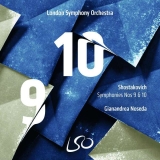 Dmitri Shostakovich: Symphonien Nr. 9 & 10; London Symphony Orchestra, Gianandrea Noseda; 1 SACD LSO Live LSO0828; Aufnahmen 2018/2019, Veröffentlichung 05/02/2021 (79'05) – Rezension von Remy Franck
Dmitri Shostakovich: Symphonien Nr. 9 & 10; London Symphony Orchestra, Gianandrea Noseda; 1 SACD LSO Live LSO0828; Aufnahmen 2018/2019, Veröffentlichung 05/02/2021 (79'05) – Rezension von Remy Franck
Shostakovichs 9. Symphonie ist eine Komposition, auf die bei Kriegsende in der Sowjetunion niemand gewartet hatte, weil sich alle eine große Siegessymphonie mit Chor und Soli erwartet hatten. Und dann kam Shostakovich mit diesem Werk, unter dessen neoklassischer Maske Angst ebenso versteckt wird wie Spott und Ironie.
Unbeschwerten Humor gibt es in dieser Neunten Shostakovichs vielleicht im ersten Satz, aber dieser Humor wird bereits im Moderato in Frage gestellt, lebt dann im Presto wieder auf, um in dem vor dem Finale eingeschobenen Largo mit viel ernst gemeinter Trauer wieder gebrochen zu werden.
Noseda bringt aber vor allem auch viel Unruhe in die Symphonie und stellt das rätselhafte Werk als durchaus problemschwanger dar.
Nach dieser Guten Neunten in Nosedas unausgeglichenem Shostakovich-Zyklus enthält der erste Satz der Zehnten zwischen Pathos und Verhaltenheit zunächst viel Unsicherheit im Gefühlsausdruck, viel Schwermut auch. Noseda schafft – wie Christoph von Dohnanyi in seiner Aufnahme aus Cleveland – ein Klima von fragiler Ruhe, ja von Furcht und Unterdrückung. Der Satz gewinnt aber immer mehr an Kraft und wird so eigentlich ganz logisch aufgebaut als Vorbereitung auf das folgende Allegro.
Der zweite Satz ist bei Noseda kein jähes, kaltes Nachtstück, sondern eine schwungvolle, federnde und farbige Musik voller Virtuosität. Im dritten Satz und auch im Andante des vierten kommt es zu schönen, vertieften und nachdenklichen Passagen. Noseda, so scheint mir, sieht in dieser Symphonie primär nicht eine Abrechnung mit dem Stalinismus, sondern einen hoffnungsvollen Ausblick auf die Zeit nach Stalin. Entsprechend klingt der Schluss der Symphonie recht enthusiastisch.
Shostakovich’s 9th Symphony is a composition that no one in the Soviet Union was waiting for at the end of the war, because everyone had expected a great victory symphony with chorus and solos. And then Shostakovich presented this work, under whose neoclassical mask fear is hidden as well as mockery and irony.
There is light-hearted humor in this Shostakovich Ninth perhaps in the first movement, but this humor is already called into question in the Moderato, then revives in the Presto, only to be broken again in the Largo inserted before the finale with much serious mourning.
Above all, however, Noseda brings a great deal of restlessness to the symphony and presents the enigmatic work as thoroughly problematic.
After this Good Ninth in Noseda’s unbalanced Shostakovich cycle, the first movement of the Tenth, between pathos and demeanor, initially contains much uncertainty in its emotional expression, much melancholy as well. Noseda creates – like Christoph von Dohnanyi in his Cleveland recording – a climate of fragile calm, even of fear and oppression. The movement gains more and more power, however, and so is actually built up quite logically as a preparation for the Allegro that follows.
In this performance, the second movement is not a motoric and dark night piece, but a swinging, bouncy and colorful music full of virtuosity. In the third movement, and also in the Andante of the fourth, there are beautiful, deep and reflective passages. Noseda, it seems to me, sees in this symphony primarily not a reckoning with Stalinism, but a hopeful outlook on the time after Stalin. Accordingly, the end of the symphony is quite enthusiastic.
























